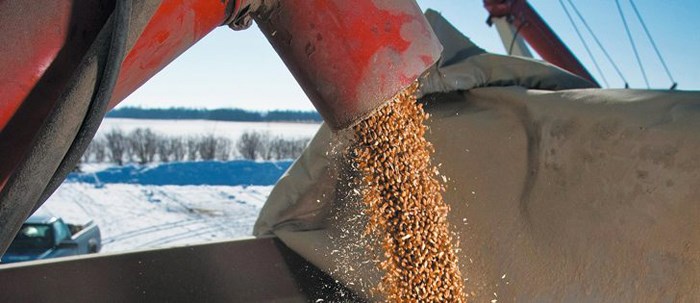Naomi Paley, BSA, PAg,
Regional Livestock Specialist,
Saskatchewan Ministry of Agriculture
After the early snow and a month of wet weather in Saskatchewan, many acres of annual grain crops are still in the field. There are growing concerns with some of the grain having sprouted and becoming unsaleable. And given the recent run of warm, dryer weather, the possibility of salvaging these crops as forage for livestock has been a popular question. But before salvage operations commence, there are a few important points to take into consideration.
If the crop was insured through Saskatchewan Crop Insurance, they must be contacted prior to any salvage operations commencing.
Economic Considerations:
Baling costs range from $15 to $18 per bale, according to the 2016-17 Farm Machinery Custom and Rental Rate Guide, so first determine if there is adequate nutritional value and a market for the feed to justify these expenses. The cost of transportation and hauling the bales to the cows should also be considered.
Baling Considerations:
Bales containing 18 to 20% moisture (or higher) have the potential to heat and lose their quality. Some of the sugars (or energy) will be used by the microbes during the heating process, reducing the energy content available to the animals. If temperatures within the bale get above 40掳C, the bales will smell sweet or like tobacco.聽 The color can change to dark brown or black.聽 When this happens, some of the protein will be tied to the fiber and not available to the animals. If this occurs, request an Acid Detergent Insoluble Nitrogen (ADIN) or ADIP (protein) test in addition to the regular feed analysis. Use the adjusted lower protein value when formulating rations.
Molds can also develop in bales with higher moisture. This can result in a loss of quality and possible feed refusal. If mold is present bales should be rolled out rather than fed through a bale processor. This will allow the cows to sort through the feed and allow them to waste the material that is contaminated with mold.聽 Forcing cows to eat 5% moldy feed can possibly reduce the digestibility of the ration by 10%.
Mature grain crops that have lain (and weathered) in the field for several weeks should not be made into chopped or bale silage. Aerobic bacteria will have established themselves in the swath and outcompete the anaerobic bacteria that develop during the ensiling process. White mold can form. Nutrient losses also occur. 聽
Applying the appropriate amount of buffered propionic or formic acid to higher moisture feed reduces mold growth and heating. These products could allow baling at 4 to 5% higher than normal.聽 However, moisture levels will remain higher than recommended and these bales should be fed out as quickly as possible. 聽
Bacteria cannot develop when temperatures are below 0掳C.聽 Letting the feed stay in the field until temperatures remain below zero could allow you to bale the crop. However, this is very risky as the time available for baling before the crop is completely snowed under may be very short. Furthermore, if temperatures rise again microbe action will begin and the risk of heating and mold growth returns.
Feeding Considerations:
There is an approximate 1:1 weight ratio of grain to straw in mature cereal crops.聽 Therefore, roughly about one half of the weight of each bale would be mature cereal grain. Depending on the type of cereal grain and the class of livestock 小蓝视频 fed, there is a real potential for grain overload or rumen acidosis to occur in cattle and sheep.聽 Care and planning will be required when feeding salvaged cereal crops as forage.
In addition to the risk of grain overload another consideration with salvaged cereal crops is the potential for the presence of ergot, fusarium and the associated mycotoxins that could be harmful to your livestock.聽 Before feeding a salvaged cereal crop it is advisable to have the feed tested for nutrient composition and screened for mycotoxins and ergot.聽 You can seek the assistance of your Regional Livestock Specialist to interpret the test results and to design a winter feeding plan in order to use the feed safely and effectively.

